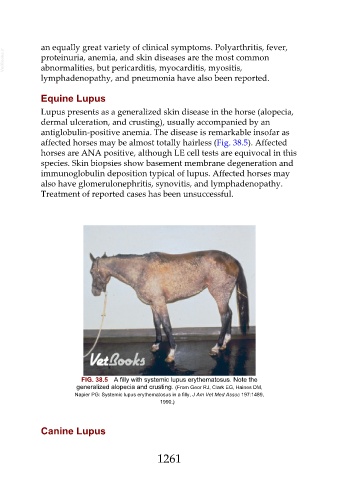Page 1261 - Veterinary Immunology, 10th Edition
P. 1261
an equally great variety of clinical symptoms. Polyarthritis, fever,
VetBooks.ir proteinuria, anemia, and skin diseases are the most common
abnormalities, but pericarditis, myocarditis, myositis,
lymphadenopathy, and pneumonia have also been reported.
Equine Lupus
Lupus presents as a generalized skin disease in the horse (alopecia,
dermal ulceration, and crusting), usually accompanied by an
antiglobulin-positive anemia. The disease is remarkable insofar as
affected horses may be almost totally hairless (Fig. 38.5). Affected
horses are ANA positive, although LE cell tests are equivocal in this
species. Skin biopsies show basement membrane degeneration and
immunoglobulin deposition typical of lupus. Affected horses may
also have glomerulonephritis, synovitis, and lymphadenopathy.
Treatment of reported cases has been unsuccessful.
FIG. 38.5 A filly with systemic lupus erythematosus. Note the
generalized alopecia and crusting. (From Geor RJ, Clark EG, Haines DM,
Napier PG: Systemic lupus erythematosus in a filly, J Am Vet Med Assoc 197:1489,
1990.)
Canine Lupus
1261

